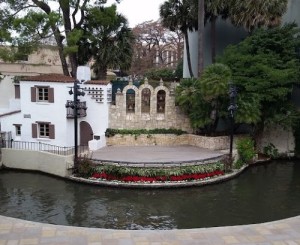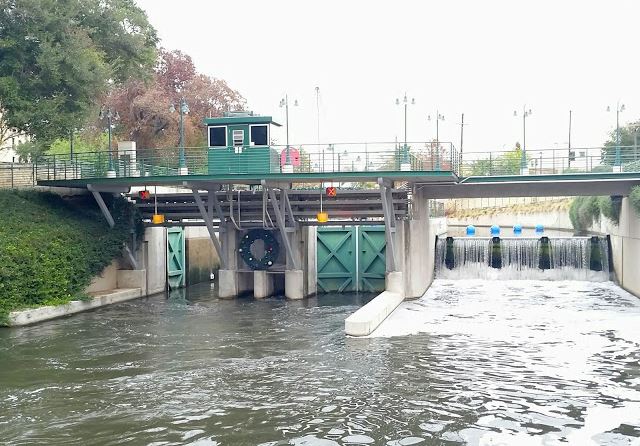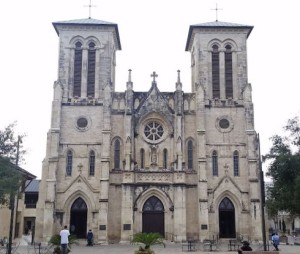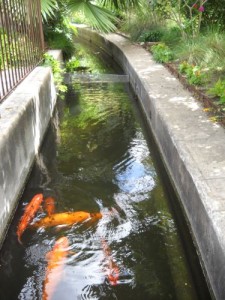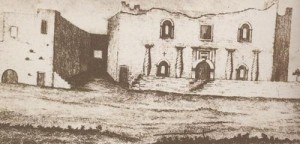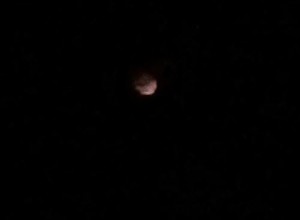While you are on the River Walk in downtown San Antonio, you will see occasional signs pointing north (well, generally north, I suspect there may be some that actually point east and will take you to a north/south part of the river, where the signs point north, and the river is not strictly straight, so some may point northeast or northwest) that say, “Witte Museum.” These signs will take you to the Museum Reach section of the River Walk.
The Museum Reach section is comparatively new. I remember one of my parents’ visits here in the 1990s my dad insisted on walking to the northern end of the River Walk. At the time, the path ended near the Hugman Dam. The San Antonio River’s elevation changes pretty suddenly both just north and just south of downtown with the end result that the current was faster than Hugman would have liked for the gondolas that he envisioned traveling up and down the river. So he put a dam in at either end of the River Walk. The water would pool up a bit behind the dams and would slow down the flow of the water. When they extended the River Walk to the north, they added a river taxi service and put an opening in the dam so that the boats can get through.
Anyway, back to the 1990s. My dad wanted to keep walking, so we continued through the underbrush for another couple of blocks after the sidewalk ended. I don’t think we went as far as McCullough, though. All of that is area paved and landscaped now and it is unrecognizable from that scrubby bank that we walked along in the 1990s.
The Museum Reach section of the River Walk is designed for use by tourists, so as you go farther north, the River Walk passes several other destinations. First is the new lock and dam that they built to take care of that elevation change and allow the boats to go on farther north on the river. If you are so inclined, you can just stand on top of the dam for hours just watching the river boats being carried up and down in the locks.
Along the way towards our next destination, the San Antonio Museum of Art (must remember to bring these links back here once I make these posts. If I never do, at least you will know that I meant to do so) you will find a public art installation called “Sonic Passage.” Sonic Passage is a sound-based installation, so there’s nothing to see, but it’s an interesting experience.
The Art Institute of Chicago, it is not, but the San Antonio Museum of Art, which is housed in the original Lone Star Beer brewery, has a lot going for it, including a very important, both regionally and nationally, collection of Asian art and most of the collection of Mexican folk art amassed by former Vice President Nelson A. Rockefeller.
Continuing farther north, we will go under Interstate 35, where you will see another art installation, ‘F.I.S.H.” F.I.S.H. is, just like the name implies, fiberglass fish. The fish light up at night, as well. Past the bridge is another installation, the concrete “Grotto.” Another former brewery, the Pearl Brewery, is the next stop. The Pearl Brewery was a working brewery until 2001 and was nearly razed after it closed. The centerpiece of the brewery, the brewhouse, was built in 1894 in a sort of I guess Second Empire style. Today the complex is home to a number of businesses, including restaurants, a hotel, and a farmer’s market that is held twice a week. The Pearl Brewery also has 324 apartments, so it is not just a restaurant complex, it is also home to (at least potentially) 324 families.
And I was right. The Pearl Brewery is Second Empire. I spent several days researching the Hugman Dam, and didn’t want to lose that kind of time on the architectural style of the Pearl Brewery. So I basically thought, “It reminds me of Philadelphia’s City Hall. What style is that?” And Philadelphia’s City Hall is Second Empire. So when I searched for “Pearl Brewery” and “Second Empire” I found all kinds of pages that backed me up.
Not too far north of the Pearl Brewery, the sidewalk ends at a big concrete structure that looks kind of like a dam. It isn’t a dam, however, it’s the flood control inlet. There is a giant tunnel underneath downtown where extra water from potential flooding is channeled underneath the city so that potential flooding won’t become actual flooding and flood downtown (as we saw in the spring of 2015, the tunnel is not 100% effective). The water comes out south of downtown and we will see the outlet in my post on Mission Reach (once Alex and I finish walking that entire distance, which probably won’t be until winter sometime — it’s October and still hot here).
If you are looking at the flood control inlet and want to continue on farther north, you have to double back to the other side of the Josephine Street overpass and go up to street level. The other side of Josephine Street is Flood Control Inlet Park. At the far side of the park, there’s a ramp that goes back down to the river level.
Enjoy the river while you can, because we’ll be leaving it (temporarily) soon. The path goes under U.S. 281 and then makes a right, but the river goes on straight. Straight through the Brackenridge Park Golf Course. They don’t want tourists walking through the golf course, so instead the path goes along the southern edge of the golf course, then along Avenue B. From Avenue B, make a left onto Mulberry and then a right onto Red Oak. At this point, you are in Brackenridge Park. A block or two down Red Oak, the path will meet up with the river again, but the river will never be quite as manicured as it was south of Flood Control Inlet Park.
Red Oak ends at Tuleta, and there is really only one direction to walk — right. There, at the intersection of Tuleta and Broadway, is the destination that the sign way back downtown was leading you — the Witte Museum.
It looks like most of the destinations I have covered are handicap accessible. There’s a ramp at Lexington, just south of Hugman Dam. There is are others at the San Antonio Museum of Art and at the Pearl Brewery. It looks like you need to be able to navigate stairs to get down to the actual flood control inlet, but the way to get back up to street level at Josphine Street sure looks like a ramp on Google Earth.
The last time I did this walk (I’ve done it twice) there was no signage indicating what to do after the flood control inlet. I suspect a lot of people just give up and go home at that point. Maybe they go back to the Pearl and throw back a beer or something. I know that if I had any interest in beer, and was less determined to find that damn museum, that’s probably what I would have done.
